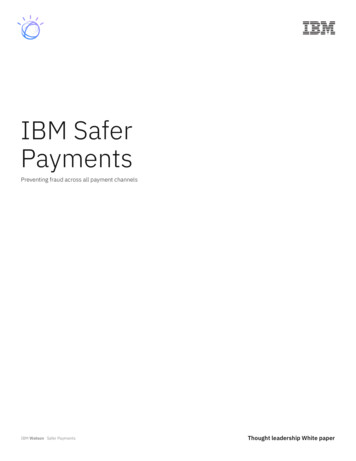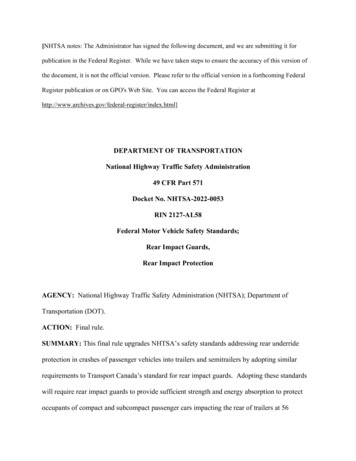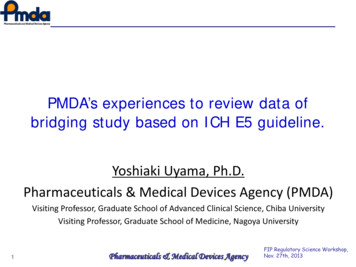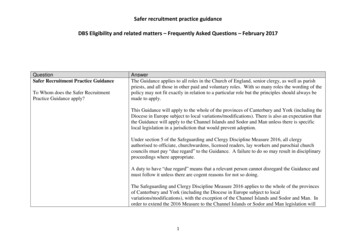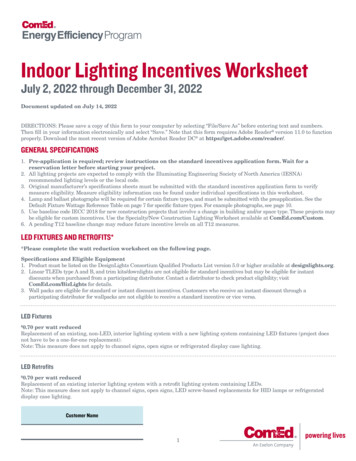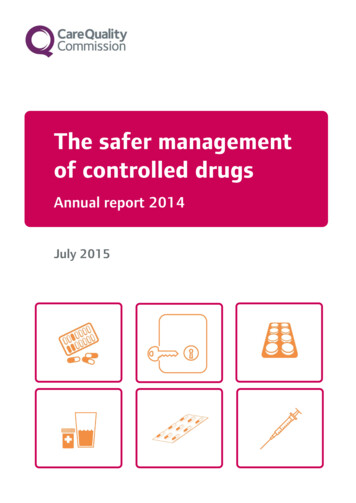
Transcription
The safer managementof controlled drugsAnnual report 2014July 2015
The Care Quality CommissionThe Care Quality Commission is the independent regulatorof health care and adult social care services in England.Our purposeWe make sure health and social care services provide people with safe,effective, compassionate, high-quality care and we encourage careservices to improve.Our roleWe monitor, inspect and regulate services to make sure they meetfundamental standards of quality and safety and we publish what wefind, including performance ratings to help people choose care.We also have a statutory duty to oversee the safe managementarrangements for controlled drugs in England.Our values Excellence -- being a high performing organisation. Caring -- treating everyone with dignity and respect. Integrity -- doing the right thing. Teamwork -- learning from each other to be the best we can.Care Quality Commission The safer management of controlled drugs: Annual report 20142
ContentsForeword . 4Summary and recommendations . 5Progress on recommendations made in the 2013 report. 9Care Quality Commission activity . 11CQC’s website . 11Register of controlled drug accountable officers (CDAOs) . 12Arrangements with NHS England and controlled drug local intelligence networks . 13Examples of good practice from CD LINs . 14Occurrence reporting . 17National Group on Controlled Drugs . 17Clinical subgroup . 21Cross-Border Group . 21National trends in the use and management of controlled drugs . 24Prescribing of controlled drugs in primary care . 24Schedule 1 controlled drugs . 24Schedule 2 and 3 controlled drugs . 24Schedule 4 controlled drugs . 26Schedule 5 controlled drugs . 27Nurse and pharmacist prescribing . 28Private prescribing of controlled drugs . 29Controlled drugs requisitions . 31Next steps . 32Appendix A: Legislation and regulations . 33Home Office controlled drugs legislation: The Misuse of Drugs Act 1971 and theMisuse of Drugs Regulations 2001 . 33Safer management of controlled drugs . 33Appendix C: Further information . 34Glossary of terms . 36Care Quality Commission The safer management of controlled drugs: Annual report 20143
ForewordThis eighth annual report provides a national picture on the regulation of controlleddrugs in England. The Care Quality Commission has a responsibility to make sure thathealth and social care providers, and other regulators, maintain a safe environment forthe management of controlled drugs. Our priority is to protect people from unsafe careand we take this responsibility seriously. This is why our Controlled Drugs team andMedicines Management Team have worked constantly to fulfil our organisational roleunder the controlled drugs regulations, as well as supporting CQC’s wider inspectionsunder the Health and Social Care Act.It is vital that we have a governance system that can pick up concerns about the misuseof controlled drugs, but at the same time can ensure that health and care staff haveproper access to them when needed for people’s clinical care.The current regulations and governance arrangements for controlled drugs wereimplemented in response to the Shipman Inquiry to support professionals and encouragegood practice around management and use. The regulations have created strengthenedcooperation between health and social care providers and the organisations that regulatethem. But in the last eight years we have seen diminishing resources, changes to thestructure of the NHS, and ever-broadening complexities of the therapeutic use -- andmisuse -- of controlled drugs. This provides continual challenges for healthcareprofessionals in the safe management and use of controlled drugs.To respond to these challenges Care Quality Commission has made recommendations -both for ourselves and for other organisations -- to make sure that we keep on workingcollaboratively and that the arrangements for controlled drugs in England continue tokeep people safe.Professor Steve Field CBE FRCP FFPHM FRCGPChief Inspector of General Practice responsible for Primary Medical Services andIntegrated CareCare Quality Commission The safer management of controlled drugs: Annual report 20144
Summary and recommendationsAs well as regulating health and care services under the Health and Social Care Act 2008,the Care Quality Commission (CQC) is responsible for making sure that health and socialcare providers, and other regulators, maintain a safe environment for the management ofcontrolled drugs in England. This was in response to the findings of the Fourth report ofthe Shipman Inquiry and the Government's response to the inquiry's recommendations.The Controlled Drugs (Supervision of Management and Use) Regulations 2013 cameinto force on 1 April 2013. This report looks at the work of CQC and other responsibleorganisations during 2014 under these regulations to ensure safe arrangements forcontrolled drugs. It also reports on prescribing data for 2014 on controlled drugs acrossEngland and identifies any trends in prescribing.One of CQC’s responsibilities around controlled drugs is to maintain and update theregister of controlled drug accountable officers (CDAOs), who are responsible for allcontrolled drug handling and governance issues in their organisation. Some smallorganisations are exempt from the need to have a CDAO, but uptake of this exemptionduring 2014 was low. Another responsibility for CQC is the need to work with localcontrolled drug intelligence networks (CD LINs) across England, and to work with leadCDAOs to identify organisations that do not engage with their CD LIN and do notprovide occurrence reports. We continued to identify and follow up where a CDAO hadleft an organisation but where we had not received a new notification for thereplacement CDAO.CQC coordinates the National Group on Controlled Drugs, which met four times during2014. The Clinical Sub Group met twice and the methadone newsletter was published onCQC’s website. We also met twice with our cross border colleagues in Wales, Scotland,Northern Ireland, Republic of Ireland, the Channel Islands and the Isle of Man, to sharegood practice and discuss controlled drugs-related issues.CQC has created self-assessment tools to enable primary and secondary careorganisations to establish areas of strength or weakness in their controlled druggovernance arrangements. We updated these in 2014, to use a more user-friendly red,amber, green (RAG) rating.This was the first full year under the 2013 Regulations and the new arrangements as setout in the NHS England Single Operating Model (SOM), which provides a framework,guidance and templates for lead CDAOs on their roles and responsibilities. There were 27NHS England area teams in 2014, but after an organisational capacity review of NHSEngland in the latter part of the year, some areas amalgamated to form 13 new regionsfrom April 2015.Care Quality Commission The safer management of controlled drugs: Annual report 20145
Although this has caused some concern in terms of the size of the regions that each NHSEngland lead CDAO is required to cover, it also provides an opportunity for bettercollaboration between lead CDAOs and a more joined up approach to sharing goodpractice. Despite some variation during 2014 in how the area teams fulfilled theirfunctions, CD LIN meetings and learning events were held across all area teams andconcerns were shared and followed up. However, in general, there continued to be onlyminimal engagement with social care organisations and a lack of capacity to monitorcontrolled drug prescribing.Discussions continued during 2014 on the feasibility of a national roll-out of the GreaterManchester Area Team (GMAT) reporting tool across England. Consequently, the jointwork between CQC and NHS England to collect national occurrence reporting data hasbeen suspended until those discussions are concluded. We will then review how best togather the national picture.National trends in the use and management of controlled drugsIn 2014, the total number of controlled drugs items prescribed in NHS primary care was60,871,306, which is an increase of 0.67% compared with 2013. The cost of this was 548,634,970, representing a decrease of 0.37% compared with 550,684,964 in2013. Prescribing of all Schedules (2, 3, 4 and 5) of controlled drugs in 2014 stayedbroadly similar to that in 2013.There were a number of legislation changes in June 2014, which included the schedulingof tramadol from a prescription only medicine (PoM) to a Schedule 3 controlled drug;zopiclone and zaleplon were also scheduled under Part 1 of Schedule 4 alongsidezolpidem following control; and lisdexamfetamine was scheduled as a Schedule 2controlled drug alongside dexamfetamine. In addition, the N-benzylatedphenethylamines (NBOMe) and benzofuran compounds (advertised for sale as ‘legalhighs’) were listed in Schedule 1 to the 2001 Regulations and designated as drugs towhich section 7(4) of the 1971 Act applies as they have no known legitimate usesoutside of research. This means they can only be possessed or supplied under a HomeOffice licence for research of other special purpose.Prescribing by nurses increased by 12% and prescribing by pharmacists increased by56% in 2014 compared with 2013. However, this still represents only a small proportionof total controlled drug prescribing. Nurses and pharmacists are principally involved inprescribing methadone and buprenorphine for the treatment of addiction, whichaccounts for the majority of prescriptions for controlled drugs from these two groups.Private prescribing accounts for a small proportion of overall controlled drug prescribing(about 0.06%). The total number of Schedule 2 and 3 controlled drug items prescribedprivately in 2014 was 38,913, which is an increase of about 5% compared with 2013.The overall pattern of private prescribing was similar to that reported in 2013.Care Quality Commission The safer management of controlled drugs: Annual report 20146
Practitioners working in healthcare settings in the community who wish to obtain a stockof a Schedule 2 or 3 controlled drug from a community pharmacy should use a standardControlled Drug Requisition Form (FP10 CDF). However, use of these forms will not bemandatory until 30 November 2015 and pharmacies can supply controlled drugsrequisitioned on non-standard forms. This makes the capturing and analysis of the datamore difficult. However, the requisition data that we do have shows that 19,323controlled drug items were requisitioned in 2014, which is only a small increase of 1%compared with 2013.2014 was a settling down period in which NHS England lead CDAOs worked hard toensure that the arrangements for the safe management of controlled drugs weremaintained following the restructure of the NHS and changes in regulations during2013.Going forward, the further restructure of NHS England must be seen as an opportunityfor greater collaboration and consistency across England.We therefore make the following recommendations.Care Quality Commission The safer management of controlled drugs: Annual report 20147
RecommendationsRecommendation for CQC CQC should make information available to small organisations to advisethem of the exemption provision in the regulations for the need toappoint a controlled drug accountable officer.Recommendations for NHS England lead controlled drug accountableofficers NHS England lead controlled drug accountable officers should use thechanges to the regional structure from April 2015 as an opportunity towork more collaboratively so that there is greater national consistency ofapproach to delivering their controlled drug responsibilities. NHS England lead controlled drug accountable officers should engagewith and formalise the support of clinical commissioning groups (CCGs) sothat monitoring controlled drug prescription activity is a higher priority. NHS England lead controlled drug accountable officers should determinehow best to engage with social care organisations in their area and shouldencourage local authorities to be engaged in controlled drug localintelligence networks (CD LINs).Recommendations for NHS England NHS England should provide guidance for occurrence reporting so thatorganisations understand what they need to report to the CD LIN.Recommendation for all controlled drug accountable officers Controlled drug accountable officers should share organisational learningfrom controlled drug-related incidents with their CD LINs and, wherepossible, develop links with their Medication Safety Officers (MSOs) tomaximise these opportunities for learning.Care Quality Commission The safer management of controlled drugs: Annual report 20148
Progress on recommendations madein the 2013 reportIn the report for 2013, CQC made seven recommendations to improve the managementof controlled drugs. In this section, we report on the progress made against these.Recommendation 1NHS England controlled drug accountable officers must be adequately resourced tocarry out their roles and responsibilities with regard to controlled drugs.Progress:During 2014, NHS England controlled drug accountable officers (CDAOs) found anumber of ways to carry out their responsibilities. These included secondments,informal arrangements with clinical commissioning groups (CCGs) and commissioningsupport units (CSUs) and other goodwill gestures. The changes to NHS England in2015 provide a new opportunity for more collaborative working, which will helpachieve greater national consistency as long as capacity is used effectively.Recommendation 2NHS England controlled drug accountable officers must be clear about theirresponsibilities for controlled drug governance arrangements and strengthen theirrelationships with CCGs and CSUs so that these organisations are clear as to howthey can support them.Progress:Although CCGs and CSUs provided some support, there was a mixed picture. Thearrangements for how CCGs should support NHS England CDAOs are now clearly setout in the delegation agreement for co-commissioning.Recommendation 3NHS England controlled drug accountable officers should consider organisinglearning events for controlled drug accountable officer colleagues and controlleddrug leads, to enable them to share learning and best practice.Progress:Most area teams organised learning events in 2014, which CDAO colleagues andsupport staff found beneficial. For example, a number of area teams joined togetherto provide full-day events with external speakers, enabling networking, discussionsand sharing good practice.Care Quality Commission The safer management of controlled drugs: Annual report 20149
Recommendation 4NHS England controlled drug accountable officers should consider extendingmembership of the controlled drug local intelligence network to other relevant localorganisations (such as social enterprise organisations or community interestcompanies) either on a permanent or ‘as required’ basis.Progress:Most controlled drug local intelligence networks (CD LINs) have broadened themembership of the open part of their meetings to include all relevant organisationsacross their patch, leading to a greater awareness of the issues faced by differentservices and a richer discussion of controlled drug-related issues.Recommendation 5A formal process should be put in place by NHS England controlled drugaccountable officers to ensure controlled drug concerns and good practice areshared nationally where appropriate.Progress:Although information was shared well across the boundaries of CD LINs during2014, there was no formal process in place to share concerns and good practicenationally. From 1 April 2015, this will be more easily achieved as all NHS Englandlead CDAOs will be members of the NHS England National Controlled Drugs Forum.Recommendation 6Healthcare providers must determine whether they are required to appoint acontrolled drug accountable officer or whether they meet the criteria for an exemption.Progress:The uptake of the exemption facility remains minimal and CQC will review how bestto inform and advise small providers about this.Recommendation 7The Care Quality Commission should summarise the key messages from theControlled Drugs National Group meetings and circulate them to NHS Englandcontrolled drug accountable officers to pass on to members of their controlled druglocal intelligence networks.Progress:CQC has circulated a summary of the minutes after each meeting, which have beenwell-received by CD LIN members. However, we are aware that the minutes are notalways shared further across organisations and we encourage each CD LIN memberto share the minutes with other relevant staff in their organisation as necessary.Care Quality Commission The safer management of controlled drugs: Annual report 201410
Activity from the Care QualityCommissionCQC’s websiteThere is a dedicated section on CQC’s website about controlled drugs, which includes: Guidance for accountable officers – who should be a CDAO, which organisationsneed a CDAO and which are exempt. Guidance on making notifications and the associated web-based forms. The register of CDAOs. Self-assessment tools. Links to the legislation and supporting information. Previous annual reports. Clinical sub-group newsletters. Primary medical services ‘Controlled drugs myth-buster’.We have been monitoring the number of visits to this section on the website since May2014, which receives an average of about 2,000 views each monthFigure 1: Number of visits to CQC’s controlled drugs web pages from May 201425002000150010005000Care Quality Commission The safer management of controlled drugs: Annual report 201411
Primary and secondary care self-assessment toolsBoth the primary care self-assessment tool and the secondary care self-assessment toolwere updated in 2014 to reflect changes to the NHS structure and to make them easierto use by replacing the numerical scoring system with a red, amber, green (‘RAG’) rating.We launched the new tools on 1 August 2014 -- initially as a pilot for six months whilewe gathered feedback from users. The number of downloads averaged at 200 a month.Register of controlled drug accountable officers (CDAOs)As required under the 2013 Regulations, CQC continues to maintain and publish a list ofCDAOs across England. Organisations that are required to have a CDAO (calledcontrolled drug designated bodies) must notify CQC of their appointment and anyongoing changes to their CDAO to enable us to keep the register up to date. The CDAOregister, the notification webform and associated guidance are all available on ourwebsite and further help and clarification is also available by emailing CQC’s ControlledDrugs team at CDAORegisterData@cqc.org.uk. Changes of contact details can also beemailed to this address.During 2014, we updated the register every month and received 261 notifications aboutCDAOs, of which 192 were from independent healthcare organisations.The 2013 Regulations also made a new provision for exemptions to the requirement toappoint a CDAO for small businesses (those with fewer than 10 staff) and for businesseswith more than 10 staff, but where it would be disproportionate to appoint someone asthe controlled drug usage is low. Where the exemption is based on size, we askorganisations to notify us so that we can remove them from the register. In some cases even though an organisation may have more than 10 staff -- it would be disproportionateto appoint a CDAO. In these cases, we ask them to notify us so that we can considergranting a time-limited exemption, during which we remove the organisation from theregister. Exemptions are granted on a case-by-case basis and are for a period of up toone year (ending 31 December each year), after which time we ask the organisation tore-apply. Uptake of this provision has and continues to be low and we believe this isbecause smaller organisations are less aware of the exemption provision.We received 14 exemption requests in 2014. To date, all exemptions applied for havebeen granted.Recommendation for CQC CQC should make information available to small organisations to advisethem of the exemption provision in the regulations for the need to appointa controlled drug accountable officer.Care Quality Commission The safer management of controlled drugs: Annual report 201412
Arrangements with NHS England and controlled drug localintelligence networksAll NHS England lead CDAOs carried out their role during 2014, but there wasconsiderable variation across the area teams despite implementation of the SingleOperating Model (SOM). Although resources remained limited, most lead CDAOsmanaged to secure some form of dedicated support resource. Clinical commissioninggroups (CCGs) and commissioning support units (CSUs) also carried out controlled drugrelated duties on behalf of the area teams, although these arrangements were generallybased on goodwill rather than anything more formal. The majority of lead CDAOsreported a lack of capacity to undertake prescription-monitoring activity in any detailand although the NHS Business Services Authority has provided prescribing reports sinceAugust 2014, capacity to monitor and follow-up prescribing concerns remains an issue.CQC attended 96 controlled drug local intelligence network (CD LIN) meetings across allarea teams during 2014. We saw that meetings were being held regularly, with most heldbetween two and four times during the year with associated learning events. There wasgenerally good engagement between organisations and regulators and many CD LINshad noticeably wider memberships (although some smaller organisations have poorattendance at meetings). However, some lead CDAOs reported that they found itdifficult to engage with their local authorities -- this is particularly important for gainingintelligence regarding social care organisations across the area. In some areas, leadCDAOs are linking with local Drug Related Death Groups and are sharing the learningfrom these groups with CD LIN members.Recommendations for NHS England lead controlled drugaccountable officers NHS England lead CDAOs should use the changes to the regionalstructure from April 2015 as an opportunity to work more collaborativelyso that there is greater national consistency of approach to deliveringtheir controlled drug responsibilities. NHS England lead CDAOs should engage with and formalise the supportof clinical commissioning groups (CCGs) so that monitoring controlleddrug prescription activity is a higher priority. NHS England lead CDAOs should determine how best to engage withsocial care organisations in their area and should encourage localauthorities to be engaged in controlled drug local intelligence networks(CD LINs).Care Quality Commission The safer management of controlled drugs: Annual report 201413
Examples of good practice from CD LINsWhen we attend CD LIN meetings, we ask members to share good practice initiativeswith us so that we can include them in our report and share the learning with otherorganisations. The following are some examples we saw in 2014.Good practice initiative 1: East of England Area TeamThe Controlled Drug Liaison Officer (CDLO) covering the geography of the East ofEngland Area Team challenged Basildon & Thurrock University Hospitals NHSFoundation Trust about the frequency of ward controlled drugs checks and whetherthey should be increased from daily to every shift change. The Chief Pharmacistfound that the trust was in line with the majority of other trusts in making a dailycheck, but this led to her develop a questionnaire, which is now in use across thewhole of East of England, and which has enabled 15 NHS trusts to share aspects oftheir controlled drugs policies relating to: Ward checks. Handling of patients own controlled drugs. Training for nurses about controlled drugs. Anticipatory medicines. Handling of non-Schedule 2 controlled drugs.The questionnaire is going to be further developed to include other areas such asdestruction and security of controlled drugs in departments that are not manned 24hours a day, seven days a week.Good practice initiative 2: Cumbria, Northumberland, Tyne and WearArea Team and CSUThe North of England Commissioning Support Unit, supported by the lead CDAOwithin Cumbria, Northumberland, Tyne and Wear Area Team, developed a system forcategorising incidents relating to controlled drugs that were reported to them andproduced a report of their findings. They categorised the incidents into the followinggroups: suspected fraudulent activity; balance discrepancies; dispensing,administration or prescribing errors; substance misuse errors and governanceconcerns. They then looked at the controlled drugs involved in each category and thetypes of incidents in more detail to gain a better oversight of occurrence reportingacross their area. This work was presented at their learning event and the NHSEngland learning event in December 2014.Care Quality Commission The safer management of controlled drugs: Annual report 201414
Good practice initiative 3: NHS Cambridgeshire and PeterboroughClinical Commissioning GroupThis CCG has produced 10 ‘Controlled Drug Factsheets’ for GP practices. They coverdifferent aspects that are important for GPs such as storage, record-keeping, anddoctors’ bags. This example shows information about destruction of controlled drugs.Care Quality Commission The safer management of controlled drugs: Annual report 201415
Good practice initiative 4: Bristol, North Somerset and SouthGloucestershire Area TeamThe lead CDAO for this area team looked at the use of controlled drugs in social careorganisations across her area. She looked at: How problems were exacerbated by the frailty and vulnerability of the patientgroup. High staff turnover and use of agency staff. A general lack of training for staff in medicines administration. The effect of minimal support from pharmacists.The CDAO wrote to care homes in the area to engage with them and to encouragebetter reporting of controlled drug incidents. She identified the need to raise theprofile of controlled drugs issues in social care with NHS England, so that this workcan be taken further at a national level. Her work was presented at the NHS Englandlearning event in December 2014.Part of the Care Quality Commission’s oversight role, as well as contributing to the workof CD LINs, is to review how effectively they are working. We compiled an overviewreport for NHS England on what we found, which echoes our recommendations in the2013 annual report around the need for appropriate resources to enable CDAOs toperform their responsibilities effectively and for clear arrangements with othersupporting organisations such as CCGs. We also gave NHS England more detailedsuggestions for further development, some of which we have highlighted: To improve the effectiveness of CD LIN meetings, continuity of membership isessential, and organisations should, as far as possible, limit attendance to an agreedmember and named deputy. NHS England lead CDAOs need to consider ways to engage with CD LIN membersbetween meetings, to keep them updated on controlled drug-related issues. Further discussion is required at a national level to address the concerns raised bythe majority of lead CDAOs who reported a lack of capacity to undertakeprescription-monitoring activity and follow up on prescribing concerns.NHS England learning eventsNHS England held two learning events in June and December 2014, which wereinformative and well-attended, and provided a good opportunity for networking. Manylead CDAOs used the presentations for their own area team learning events.Care Quality Commission The safer management of controlled drugs: Annual report 201416
Occurrence reportingIn 2013, CQC set out to collect high-level data on the number of controlled drugoccurrences reported to each NHS England area team to enable us to see the nationalpi
outside of research. This means they can only be possessed or supplied under a Home Office licence for research of other special purpose. Prescribing by nurses increased by 12% and prescribing by pharmacists increased by 56% in 2014 compared with 2013. However, this still represents only a small proportion of total controlled drug prescribing.


